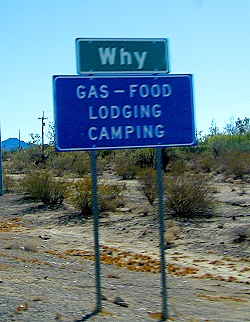
Everybody has to ask “Why?” from time to time. Our time came on the drive to Organ Pipe Cactus National Monument.
On the northern edge of the park, along the only road going in, lies the miniscule town of Why, Arizona.
Wondering why, we figured we should ask around. The Why-Not Travel Store seemed a good place to inquire. Actually, it was the only place to inquire.
It seems there are two main stories as to how the town came to be named Why, one more likely true than the other.
Some folks say that back when this place was known as Rocky Point Junction (the turning point for going to Rocky Point, Mexico) a post office was needed, but the postal service felt that there were too many towns with Junction in their names.
Needing a new name, the town held a meeting to come up with a good one, but some smart alec asked “Why would anyone live out here?” After some discussion, they all agreed. Why?
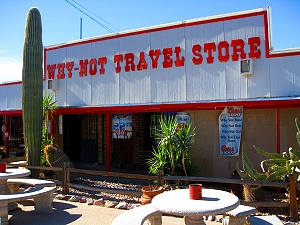
The more likely truth is that the town is named for the junction of State Routes 85 and 86 that meet in a “Y” intersection here.
Arizona law requires that town names have at least three letters so Y became Why.
Having found an answer to the ultimate question, we took the Highway 85 stem of the Y south to see the Organ Pipe Cacti. Legend has it that State 85 was donated to the federal government during Prohibition when it was a mere dirt road.
Why? The hope was that the road would be improved, making bootleg liquor easier to smuggle in from Mexico.
Guess the feds forgot to ask “Why?” when Arizona offered it to them.
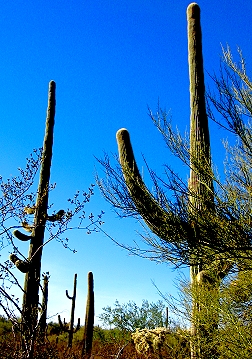
Driving into the park we spied the classic, arms-in-the-air Saguaro cacti, but soon noticed something new – the clumps of long pipe-like limbs of the Organ Pipe variety.
We chatted up a Park Ranger to find out that the park is here because this is the only place in the U.S.A. where this particular cactus grows, so in 1937 the area was officially protected as Organ Pipe Cactus National Monument.
That got us to wondering, what is the difference between a National Monument and a National Park?
The difference is mainly in the manner that they are created. A National Park can only be established through an act of congress and can consist of both public and private lands, while a Monument is designated by Presidential proclamation and can only include existing public land. Now we know.
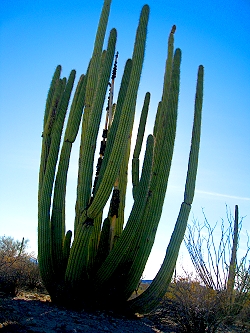
A part of the Sonoran Desert, 95% of Organ Pipe Cactus National Monument is a wilderness area and is among the hottest and driest places in the country.
With this in mind, we didn’t want to stray too far off the beaten path, but we did want to do a little hiking to see the desert up close and personal.
The two and a half mile excursion to the old Victoria Mine looked to be the best option to do some sightseeing without worries of dehydration or becoming food for wildlife.
Gold and silver mining began in this area in the late 1800s and continued for nearly one hundred years. The Victoria Mine was active for about forty of those years, around the turn of the 19th to 20th centuries. Those miners had to be hardy souls.
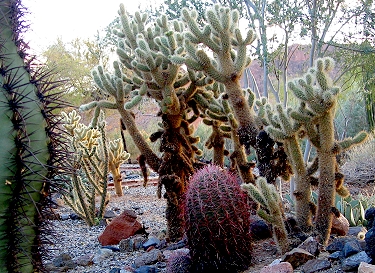
We headed out across the foothills of the Sonoyta Mountains to do a bit of prospecting of our own. Along the trail we got a taste of the desert flora and fauna.
Several types of cholla grow like crazy out here, as well as creosote bush, ocotillo, paloverde and many cacti, including the park’s namesake, organ pipes.
Wildlife is less obvious during the daylight hours, but we did see a few small birds, hawks and a couple of the little desert mice they were hunting.
As we climbed a bit higher, a beautiful panoramic view of the Sonoyta Valley spread out below us to the south. We could see all the way to Mexico. Of course Arizona was once part of Mexico, and back then the trail we were following was the old Mexican road that ran between the towns of Sonoyta and Ajo (yup, it means garlic!).
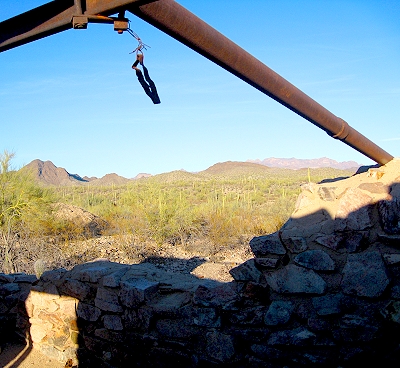
The colorful rock tailings along the mountainsides, left from the removal of the ore, let us know we were close to the mine.
At the top of the last hill we found the remnants of a stone structure next to one of several shafts. The small ruins are all that’s left of Levy’s store, which supplied the little settlement that grew here a century ago.
The only merchandise left inside the store is an old rusty bath tub. We didn’t see a price tag, but didn’t really want to drag it back to camp with us anyway.
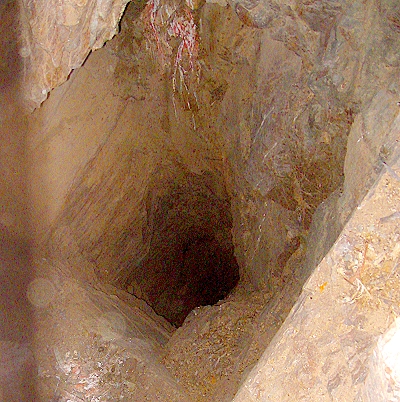
Outside the store, a good bit of the mining machinery has survived. Much of it has been moved away from the holes and the mineshafts have been covered.
We still managed a peek down the shafts, carefully looking down the dark holes through cracks in the coverings.
Not much to see but pure blackness past the first few feet, still, we’d bet every single person to come up here has done the exact same thing.
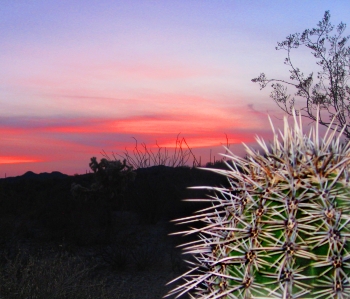
If we wanted more mining exploration, we could have continued south another two miles to the Lost Cabin Mines, but the trail gets a little spotty and we didn’t have a very good map.
At least that’s the excuse we settled on as we set out on the return trip back to the park headquarters.
Back in the middle of the desert again, we started to rethink our opinion of how the town of Why got its name.
Maybe they are here for the cacti. Why not?
David & Veronica, GypsyNester.com


